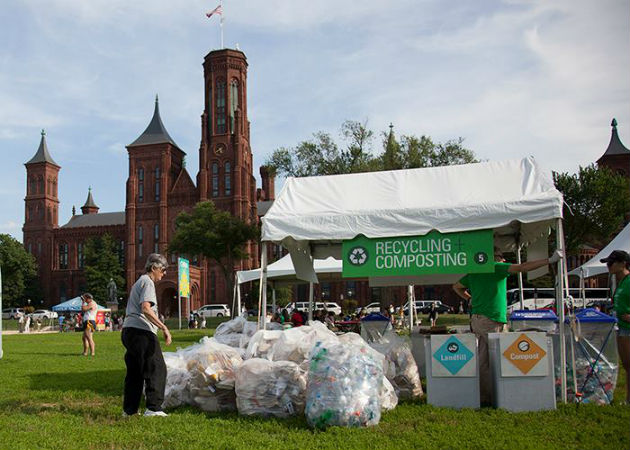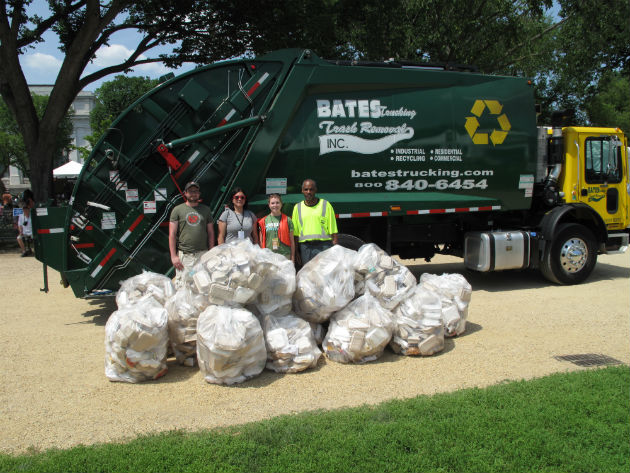Striving for Sustainability at the Festival

Did you know that the Folklife Festival is the largest composting and recycling effort on the National Mall? At the 2014 Festival, volunteers at “resource recovery stations” sorted the waste from Festival concessions stands and activities, successfully saving 93 percent of it from landfills!
Sarah Gaines has interned on the sustainability team for both the 2014 and 2015 Festivals. Media intern Georgia Dassler met with her to discuss sustainability plans for this year.
What made last year so successful?
The main reason why our diversion rate (the percentage of waste that’s diverted from a landfill) improved so much from 74 percent two years ago to 93 percent last year was because we got the food vendors on board. We not only sorted waste from the Festival visitors, but we also sorted in the back-of-house at the concession stands. We were able to recycle their cardboard, metal cans, and tons of glass bottles. All that went into a landfill were things like plastic packaging from ingredients and plastic gloves. Most importantly, we composted over 13 tons of organic waste from kitchens.


What are some of the biggest changes between last year and this year?
The biggest change is the resource recovery station design. We have 11 stations spread out throughout the Festival. Last year our success was based on the flexibility and adaptability of having separate bins for recycling, compost, and landfill-bound waste. Our new stations look like long tables with three holes. The tabletops are see-through, so you can actually see what goes in each bin. For visitors, it’s a lot more obvious where everything goes. For the volunteers and our sustainability team, however, the table makes it harder to see when, for example, someone puts a banana peel in the recycling. No matter what, our volunteers are fantastic, they’re very passionate, and they can handle it. We definitely appreciate and depend on them.
We have also worked with the National Park Service to remove their trash cans on our section of the Mall, because last year there was a certain amount of waste that “leaked” to those bins and was not captured by our stations. Not having those extra bins means that we will receive a lot more waste, which is a good thing.

Why is the sustainability initiative important to the Festival?
There is always some sort of tie between the Festival program and environmental stewardship. It’s definitely there this year with the Perú: Pachamama program. Pachamama means Mother Earth, and stewardship is deeply engrained in Peruvian culture. The Smithsonian mission is to increase and diffuse knowledge, and I think it’s very important to educate people on how they can “green” any special event and how that should, in fact, be the standard.
Compost reduces methane emissions—because there’s less decomposition in landfills—reducing the effects of global climate change. Recycling paper means that fewer trees are cut down, while recycling plastic means we don’t need to make as much new plastic from fossil fuels.
The Folklife Festival is definitely an extreme because of the high volume of people and the high volume of waste, but all of the techniques that we’re using are simple. Requiring vendors to have compostable products is a very basic concept that you can even use for a backyard party—just use paper plates! These are very simple changes that you can make on a day-to-day basis. It’s just a matter of reminding people.
Interested in joining the sustainability volunteer team? Apply online, or contact volunteer coordinator Becky Squire at CFCH-Volunteer@si.edu for more information.
Sarah Gaines studies architecture and environmental geography at the University of Toronto. She is an intern with the Smithsonian Office of Facilities Management and Reliability and is returning for her second year on the sustainability team at the 2015 Folklife Festival.

